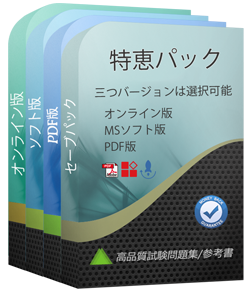あなたのテストエンジンはどのように実行しますか?
あなたのPCにダウンロードしてインストールすると、Snowflake DSA-C03テスト問題を練習し、'練習試験'と '仮想試験'2つの異なるオプションを使用してあなたの質問と回答を確認することができます。
仮想試験 - 時間制限付きに試験問題で自分自身をテストします。
練習試験 - 試験問題を1つ1つレビューし、正解をビューします。
DSA-C03テストエンジンはどのシステムに適用しますか?
オンラインテストエンジンは、WEBブラウザをベースとしたソフトウェアなので、Windows / Mac / Android / iOSなどをサポートできます。どんな電設備でも使用でき、自己ペースで練習できます。オンラインテストエンジンはオフラインの練習をサポートしていますが、前提条件は初めてインターネットで実行することです。
ソフトテストエンジンは、Java環境で運行するWindowsシステムに適用して、複数のコンピュータにインストールすることができます。
PDF版は、Adobe ReaderやFoxit Reader、Google Docsなどの読書ツールに読むことができます。
割引はありますか?
我々社は顧客にいくつかの割引を提供します。 特恵には制限はありません。 弊社のサイトで定期的にチェックしてクーポンを入手することができます。
あなたはDSA-C03試験参考書の更新をどのぐらいでリリースしていますか?
すべての試験参考書は常に更新されますが、固定日付には更新されません。弊社の専門チームは、試験のアップデートに十分の注意を払い、彼らは常にそれに応じてDSA-C03試験内容をアップグレードします。
購入後、どれくらいDSA-C03試験参考書を入手できますか?
あなたは5-10分以内にSnowflake DSA-C03試験参考書を付くメールを受信します。そして即時ダウンロードして勉強します。購入後にDSA-C03試験参考書を入手しないなら、すぐにメールでお問い合わせください。
返金するポリシーはありますか? 失敗した場合、どうすれば返金できますか?
はい。弊社はあなたが我々の練習問題を使用して試験に合格しないと全額返金を保証します。返金プロセスは非常に簡単です:購入日から60日以内に不合格成績書を弊社に送っていいです。弊社は成績書を確認した後で、返金を行います。お金は7日以内に支払い口座に戻ります。
更新されたDSA-C03試験参考書を得ることができ、取得方法?
はい、購入後に1年間の無料アップデートを享受できます。更新があれば、私たちのシステムは更新されたDSA-C03試験参考書をあなたのメールボックスに自動的に送ります。
Tech4Examはどんな試験参考書を提供していますか?
テストエンジン:DSA-C03試験試験エンジンは、あなた自身のデバイスにダウンロードして運行できます。インタラクティブでシミュレートされた環境でテストを行います。
PDF(テストエンジンのコピー):内容はテストエンジンと同じで、印刷をサポートしています。
Snowflake SnowPro Advanced: Data Scientist Certification 認定 DSA-C03 試験問題:
1. You're working with a large dataset containing customer purchase history. You want to identify customers whose purchase frequency deviates significantly from the average purchase frequency of all customers. The dataset is in a table named 'purchase history' with columns 'customer id' and 'purchase date'. What combination of Snowflake functionalities will allow you to achieve this task efficiently?
Choose all that apply.
A) Use the window function to divide customers into quantiles based on their total purchase count.
B) Employ the 'QUALIFY clause along with window functions to filter customers based on a condition related to their purchase frequency compared to the average.
C) Calculate the average purchase frequency across all customers using and group by 'customer_id'.
D) Calculate the Z-score of each customer's purchase frequency using 'AVG(Y, 'STDDEV()' , and window functions, and then filter based on a Z-score threshold.
E) Create a UDF that computes the purchase frequency for a single user and apply it to all customers.
2. You are building a machine learning model to predict loan defaults. You have a dataset in Snowflake with the following features: 'income' (annual income in USD), 'loan_amount' (loan amount in USD), and 'credit_score' (FICO score). You need to normalize these features before training your model. The data has outliers in both 'income' and 'loan_amount', and 'credit_score' has a roughly normal distribution but you still want to standardize it to have a mean of 0 and standard deviation of 1. You want to perform these normalizations using only SQL in Snowflake (no UDFs). Which of the following SQL transformations are most suitable?
A) Option E
B) Option B
C) Option D
D) Option C
E) Option A
3. You are tasked with automating the retraining of a Snowpark ML model based on the performance metrics of the deployed model. You have a table 'MODEL PERFORMANCE that stores daily metrics like accuracy, precision, and recall. You want to automatically trigger retraining when the accuracy drops below a certain threshold (e.g., 0.8). Which of the following approaches using Snowflake features and Snowpark ML is the MOST robust and cost-effective way to implement this automated retraining pipeline?
A) Implement a Snowpark ML model training script that automatically retrains the model every day, regardless of the performance metrics. This script will overwrite the previous model.
B) Implement an external service (e.g., AWS Lambda or Azure Function) that periodically queries the "MODEL_PERFORMANCE table using the Snowflake Connector and triggers a Snowpark ML model training script via the Snowflake API.
C) Create a Snowflake task that runs every hour, queries the 'MODEL_PERFORMANCE table, and triggers a Snowpark ML model training script if the accuracy threshold is breached. The training script will overwrite the existing model.
D) Use a Snowflake stream on the 'MODEL_PERFORMANCE table to detect changes in accuracy, and trigger a Snowpark ML model training function using a PIPE whenever the accuracy drops below the threshold.
E) Create a Dynamic Table that depends on the 'MODEL PERFORMANCE table and materializes when the accuracy is below the threshold. This Dynamic Table refresh triggers a Snowpark ML model training stored procedure. This stored procedure saves the new model with a timestamp and updates a metadata table with the model's details.
4. You have built an external function to train a PyTorch model using SageMaker. The model training process requires a significant amount of CPU and memory. The training data is passed from Snowflake to the external function in batches. The external function code in AWS Lambda is as follows:
The Snowflake external function is defined as follows:
During testing, you encounter '500 Internal Server Error' from the external function consistently. Upon inspection of the Lambda logs, you find messages indicating 'PayloadTooLargeError'. What is the most likely cause and how do you mitigate it within the context of Snowflake and AWS Lambda?
A) The size of the data being sent from Snowflake to the Lambda function exceeds the maximum payload size allowed by AWSAPI Gateway. Increase the maximum payload size limit in the API Gateway settings.
B) The Snowflake external function definition is incorrect. Change the 'RETURNS VARIANT clause to 'RETURNS VARCHAR as the Lambda function returns a JSON string.
C) The IAM role associated with the Lambda function lacks the necessary permissions to invoke the SageMaker training job. Grant the Lambda function's IAM role the appropriate SageMaker permissions.
D) The size of the data being sent from Snowflake to the Lambda function exceeds the maximum payload size allowed by AWS API Gateway. Implement data partitioning in Snowflake and send smaller batches of data to the Lambda function, aggregating the results in a separate table.
E) The Lambda function is timing out before the model training can complete. Increase the Lambda function's timeout setting to allow sufficient time for the training process.
5. You are using a Snowflake Notebook to analyze customer churn for a telecommunications company. You have a dataset with millions of rows and want to perform feature engineering using a combination of SQL transformations and Python code. Your goal is to create a new feature called 'average_monthly call_duration' which calculates the average call duration for each customer over the last 3 months. You are using the Snowpark DataFrame API within your notebook. Given the following code snippet to start with:
A) Option E
B) Option B
C) Option D
D) Option C
E) Option A
質問と回答:
| 質問 # 1 正解: B、D | 質問 # 2 正解: D | 質問 # 3 正解: E | 質問 # 4 正解: D | 質問 # 5 正解: C、D |


 弊社は製品に自信を持っており、面倒な製品を提供していません。
弊社は製品に自信を持っており、面倒な製品を提供していません。



 -萩野**
-萩野**

